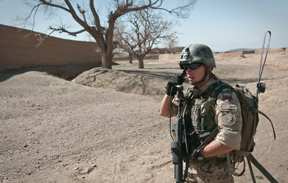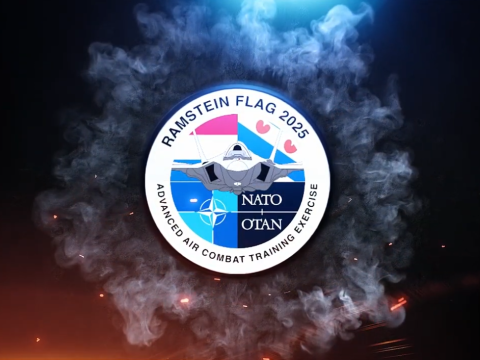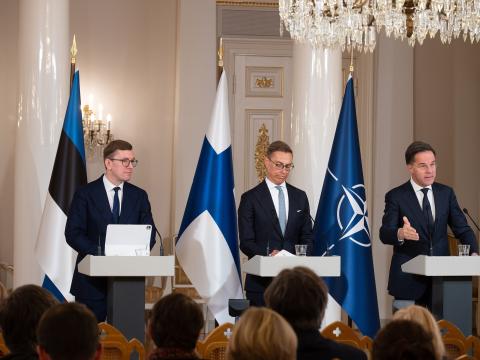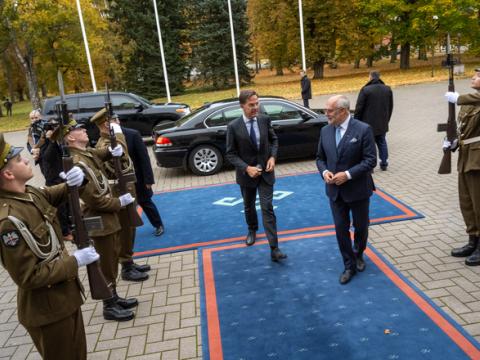Technology and the Warfighter Come Together in NATO
 |
|
| A Polish soldier serving with the International Security Assistance Force maintains radio contact while on patrol in Afghanistan. The creation of the new NATO Communications and Information (NCI) Agency consolidates several legacy agencies into a single organization with the goal of speeding new technologies to the warfighter faster. |
The absorption of several NATO agencies into a single entity, coupled with the need to reform the acquisition of information systems, is clearing the way for the Atlantic alliance to speed the newest information technologies to warfighters far more quickly than previously attainable. The new entity will serve all aspects of communications and information technology development and acquisition under a single umbrella organization.
With all these eggs in one basket, NATO aims to eliminate redundancy and bottlenecks. The goal is to ensure that NATO forces receive the newest technologies without seeing their systems approach obsolescence before fielding is completed. Efficiencies inherent in the new construct also would save valuable funds as defense budgets worldwide face significant cuts from financial pressures.
The NATO Communications and Information Agency, or NCI Agency, resulted from the melding of the NATO Consultation, Command and Control Agency (NC3A); the NATO Air Command and Control System (ACCS) Management Agency (NACMA); the NATO Communication and Information System (CIS) Services Agency (NCSA); the Active Layered Theater Ballistic Missile Defense (ALT BMD) program; and elements of the NATO Headquarters Information, Communication and Technology Management (ICTM) directorate along with other programs.
Maj. Gen. Koen Gijsbers, RNLA (Ret.), is the general manager of the NCI Agency. He says that the main difference between the newly formed agency and its predecessors is that the new organization will be responsible for command, control, communications, computers, intelligence, surveillance and reconnaissance (C4ISR) systems “from cradle to grave.” Many of these responsibilities were divided among the older organizations, which led to bottlenecks and internal communication issues.
This improved coherence is what NATO’s member nations are seeking in the C4ISR environment, the general continues. It constitutes an enterprise vision and the execution of that vision for NATO command and control (C2). By abandoning the approach that entailed separate domains, NATO elements can work together better and improve interoperability. Ultimately, NATO nations will be linked together better, he says.
The global financial crisis, particularly the uncertainty with the euro, has crimped many nations’ defense budgets. Gen. Gijsbers notes that NATO is reducing the size of its command structure as well as other personnel through agency reform. In part, these activities reflect pressure from member nations that are forced to reduce their own militaries as a result of budget pressures. Gen. Gijsbers relates that he has established financial targets based on the new budgetary conditions, and the goal is to deliver better capabilities but at lower cost.
Change is likely to be evolutionary rather than revolutionary, he continues. A key element will be C4ISR collaboration among nations with the agency. “I think this is a great opportunity for NATO—for the nations and for the agency—to develop not only less expensive solutions but also better interoperability,” Gen. Gijsbers states. “It is much easier to achieve interoperability at the application level between our forces than if you have your own different systems.”
Large programs that are in progress will continue to be delivered, he says. In future programs, member nations likely will opt to employ NATO software on their networks. The success of the Afghan Mission Network, which connected many separate national networks, is a driver for this trend, he suggests. As those nations used NATO solutions on their own networks, they discovered ways of applying them to their domestic requirements. The result is improved interoperability and reduced expenses. “We are working closely with [individual] nations to take steps in that direction, and I believe that this will continue as part of the Smart Defense Initiative undertaken by the [NATO] secretary general,” he offers.
Gen. Gijsbers identifies three programs as vital. One is the cyber program, which aims to improve alliance cyber capabilities. This will remain high on the priority list for some time, he allows. The second is missile defense. The third involves the ISR environment. Efforts such as the NATO Alliance Ground Surveillance program may benefit from the agency’s ability to deliver capabilities to the operational community better. The Air Command and Control System and the Automated Information Systems program also are among the agency’s main priorities.
At the top of Gen. Gijsbers’ priority list is modernizing NATO’s information technology infrastructure. “We need to innovate and obtain more modern technology in this infrastructure,” he states. “This will allow us to improve services to the whole community. We are linking the deployable part to the static part of the alliance.”
The consolidation will help NATO improve its information technology infrastructure and services more quickly than previously possible, the general adds. “It is vital for success. You need to have a solid infrastructure if you want to develop more solutions and applications for users,” he emphasizes.
“This is a real opportunity to build something from the experiences that we have had and the lessons that we have all learned,” the general continues. “We are building on the foundations of the old organizations, because we are not going to forget what they brought—all very good work—but now we have the opportunity to improve some of the internal processes and bring people together.”
The NCI Agency now has ownership of the equipment that is part of the new NATO Communications and Information Systems Group. This allows the agency to view information technology support to the operational community as an enterprise, which advances the thrust to ensure that operational needs and support are synchronized.
Gen. Gijsbers relates that a recent C2 agreement he signed with Supreme Allied Commander Europe (SACEUR) will help ensure that the agency delivers the best services it can to the operational community. Security is one of those services. Gen. Gijsbers emphasizes that security cannot be run as a business; instead it must be run as an operation.
From an industry perspective, the new agency provides a single entry point for businesses seeking to provide C4ISR systems to NATO. The NCI Agency effectively becomes a single acquisition organization, Gen. Gijsbers points out. It will collect requirements from NATO organizations in “a more coherent manner” and identify them for industry. “We actually are going to work closer with industry to get best industry practices into the agency,” he says.
“We need to do better with less,” Gen. Gijsbers says, echoing the sentiments of many Western military planners.
The NCI Agency is looking at how it can involve industry in its many efforts, the general continues. One hurdle to overcome is that, when industry is involved in a program early, then problems may emerge when the program goes to market. Before going to industry, the agency must find ways of mitigating this issue.
Some of the tools available to meet that challenge include the Network Centric Operations Industry Consortium and the NATO Industrial Advisory Group, for example. Gen. Gijsbers declares that he intends to work closely with these and other types of organizations to understand better what industry can deliver—and what the agency should ask of industry to obtain the best solutions.
Above all, industry should “deliver to us the best at the lowest cost,” the general states. “I am really going to be critical of the price of what we are going to acquire.” He cites as an example the rationalization of software use. Industry should bring better solutions without duplication of effort.
The NCI Agency focuses largely on NATO C4ISR at the brigade level and above. However, some developments at the tactical level—which is not the NCI Agency’s purview—are affecting those higher-level efforts. The introduction of mobile communications technologies such as smartphones will influence system planning. Ongoing efforts to make smartphone security solutions platform-agnostic will improve interoperability among different nations, and this effect may be felt at all levels of alliance information technology, Gen. Gijsbers suggests.
“We need to be able to link different solutions together,” he says. “Because we are a multinational organization with 28 nations, we will give work to industries of the different nations. It is essential for us to get an architecture where heterogeneity—not homogeneity—of the solution is the driver,” he says describing the different solutions that countries bring to the table.
“That is the challenge. Going for one simple solution might not be feasible in an international environment,” he explains. “Commercial technology will be more important.”
Overall, the general declares that he sees more opportunities than challenges. Beginning with the agency itself, personnel like the way they can work together toward a single goal in a single organization. This is one culture change that is not a challenge, he emphasizes.
He expresses one concern that the merger will focus too much on change management and not enough on delivery of services. With his operational background, Gen. Gijsbers declares that it is vital for the success of the agency for it to deliver the needed services. Ensuring that delivery of services remains foremost among the NCI Agency’s taskings is a high priority.
Gen. Gijsbers points out that the NCI Agency will be completely customer funded. This will require “a lot of work,” he says, but NATO nations are committed to the concept of the agency earning its own money without core funding. “Going from budget funding for two-thirds of the agency to customer funding for all of the agency will require quite some work,” he notes. “But, I’m confident that we can do it.”
One example the general cites as an element that might benefit from some consolidation is air C2. Currently, NATO conducts air C2 development and technical work in eight different locations. Having eight centers probably is not the best approach, he posits, and some type of consolidation would benefit the alliance. Merging agencies helps create effective teams to develop solutions. “It’s not only an administrative issue,” he states. “We need to do it by building a team, getting people together and focusing on clear objectives.”
The NCI Agency will be working more closely with member nations and their industries to link national and NATO goals and solutions. Not only will this help the alliance arrive at interoperable solutions for its own needs, it also will help individual nations develop their own solutions that will work with other nations. One approach that the NCI Agency will pursue is to try to apply solutions from one program to others.
“NATO and the agency can be a helping hand to nations to arrive at solutions,” he says.




Comments